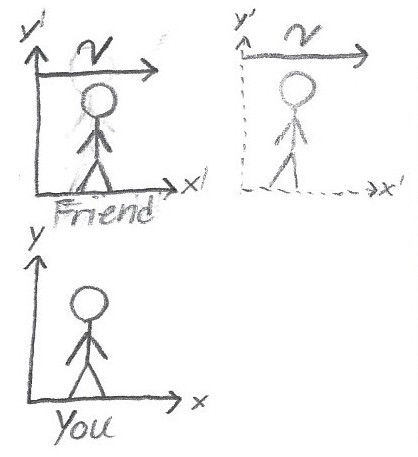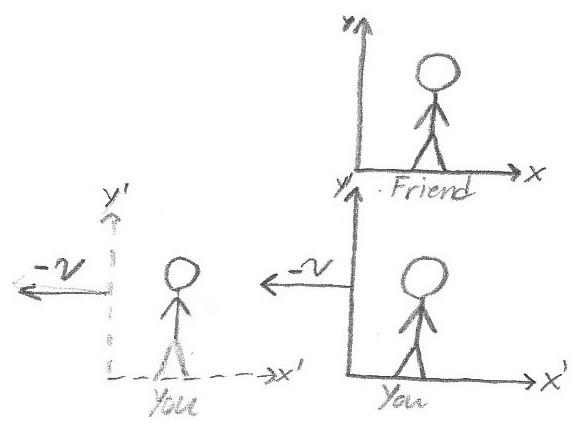Galilean Transformation & Newtonian Relativity
In 1632, natural philosopher Galileo Galilei in his book Dialogue Concerning the Two Chief World Systems proposes the concept of relative motion, where in an observer below deck of a ship travelling at a constant velocity in calm water wouldn't be able to tell whether they are moving or not.
Today, to describe such a behavior, we would use the term Inertial Frame of Reference, meaning the immediate area surrounding an observer, in which measurements can be made, with the only restriction being that the frame is not accelerating. Galileo postulated that motion is relative to the observer and is related by rules called a Galilean Transform to convert between them. To understand such a concept, let's use a few illustrations.

Example 1.1
Above, as your friend walks by you, their frame is moving along with them while you are standing still.

Example 1.2
However, from the reference frame of your friend, you and your frame are the ones who are moving, though antiparallel to your observation.

Example 2
To interpret how other inertial frames are observing an object, the Galilean transform can be used to relate motion between two inertial reference frames. And, by extension, describes how another inertial frame detects the motion of an object, by the intuition of velocity addition and subtraction.
In Newton's Principia, published July 5, 1687, it described how Galilean Relativity works within the bounds of mathematics with Newton's laws of motion (as well as his laws of motion), which hold not only in, but also between, all inertial frames of reference.
Newton wrote in Corollary V, “The motions of bodies included in a given space are the same among themselves, whether that space is at rest, or moves uniformly forward in a right line without any circular motion,” effectively stating that all physical motion is the same in all inertial frames of reference.
The underlying axioms of Newton's Relativity was the existence of a universal space (that the universe is an absolute frame of reference), and that all time is the same, and that 1 second for any observer is 1 second for the universe.
Light, as a form of fast-moving corpuscle (particle) proposed by Newton, was also believed to follow the laws of his relativity. This was the beginning of classical mechanics, which is still used to this day to describe the motion of objects at slow speeds relative to the speed of light!